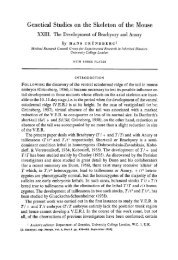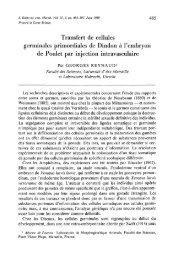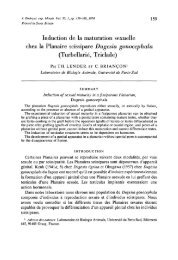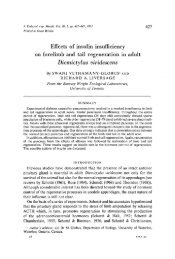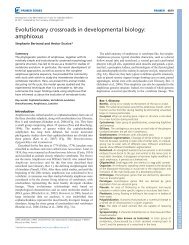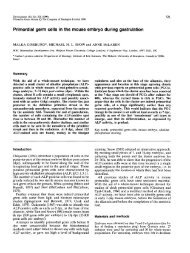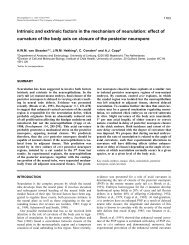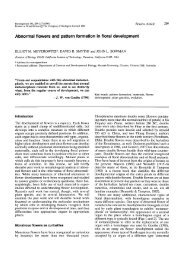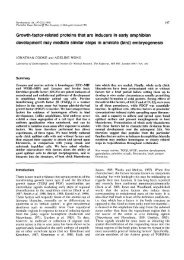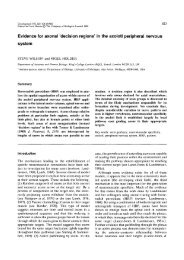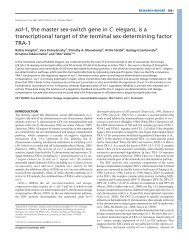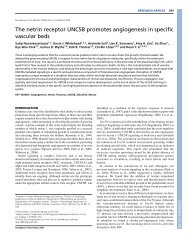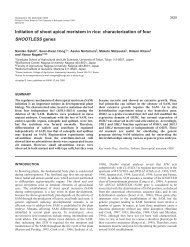View - Development - The Company of Biologists
View - Development - The Company of Biologists
View - Development - The Company of Biologists
You also want an ePaper? Increase the reach of your titles
YUMPU automatically turns print PDFs into web optimized ePapers that Google loves.
<strong>Development</strong> 128, 233-242 (2001)<br />
Printed in Great Britain © <strong>The</strong> <strong>Company</strong> <strong>of</strong> <strong>Biologists</strong> Limited 2001<br />
DEV7838<br />
Hindgut visceral mesoderm requires an ectodermal template for normal<br />
development in Drosophila<br />
Beatriz San Martin and Michael Bate*<br />
Department <strong>of</strong> Zoology, University <strong>of</strong> Cambridge, Downing Street, Cambridge CB2 2EJ, UK<br />
*Author for correspondence (e-mail: cmb16@cus.cam.ac.uk)<br />
Accepted 7 November; published on WWW 21 December 2000<br />
SUMMARY<br />
During Drosophila embryogenesis, the development <strong>of</strong> the<br />
midgut endoderm depends on interactions with the<br />
overlying visceral mesoderm. Here we show that the<br />
development <strong>of</strong> the hindgut also depends on cellular<br />
interactions, in this case between the inner ectoderm and<br />
outer visceral mesoderm. In this section <strong>of</strong> the gut, the<br />
ectoderm is essential for the proper specification and<br />
differentiation <strong>of</strong> the mesoderm, whereas the mesoderm is<br />
not required for the normal development <strong>of</strong> the ectoderm.<br />
Wingless and the fibroblast growth factor receptor<br />
INTRODUCTION<br />
In the Drosophila embryo, the mesoderm becomes subdivided<br />
soon after gastrulation into populations <strong>of</strong> cells that will give<br />
rise to the various mesodermal derivatives (Bate, 1993).<br />
Although we now have a good understanding <strong>of</strong> the<br />
mechanisms by which mesodermal cell fates are allocated in<br />
the trunk (or segmented region) <strong>of</strong> the embryo (Baylies et al.,<br />
1998; Frasch, 1999), little is known about how the terminal<br />
mesoderm is organised, or the mechanisms by which it is<br />
patterned.<br />
Visceral muscle forms the outer layer <strong>of</strong> the gut. It arises<br />
from clusters <strong>of</strong> cells in both the trunk and terminal mesoderm<br />
and develops in concert with the inner layer <strong>of</strong> the gut, which<br />
is composed both <strong>of</strong> endodermal cells (midgut) and ectodermal<br />
cells (foregut and hindgut). Two subtypes <strong>of</strong> visceral muscle<br />
envelop the midgut endoderm, the circular visceral muscle,<br />
which arises in the trunk <strong>of</strong> the embryo (Tremml and Bienz,<br />
1989; Azpiazu and Frasch, 1993), and the longitudinal visceral<br />
muscle, which arises from the caudal mesoderm (Georgias et<br />
al., 1997; Broihier et al., 1998; Kusch and Reuter, 1999). To<br />
emphasise their distinct origins, the subtypes <strong>of</strong> visceral<br />
mesoderm have been referred to as the trunk visceral<br />
mesoderm and caudal visceral mesoderm (Broihier et al., 1998;<br />
Kusch and Reuter, 1999). Since the hindgut visceral muscle<br />
also arises from the caudal mesoderm and the longitudinal<br />
visceral muscle eventually ends up in the trunk <strong>of</strong> the embryo,<br />
we feel that this terminology could lead to confusion. For these<br />
reasons, we would like to propose a simple and logical<br />
nomenclature for the different subtypes <strong>of</strong> visceral mesoderm<br />
in the Drosophila embryo. We have designated the circular<br />
233<br />
Heartless act over sequential but interdependent phases <strong>of</strong><br />
hindgut visceral mesoderm development. Wingless is<br />
required to establish the primordium and to enhance<br />
Heartless expression. Later, Heartless is required to<br />
promote the proper differentiation <strong>of</strong> the hindgut visceral<br />
mesoderm itself.<br />
Key words: Drosophila, Embryo, Visceral mesoderm, Hindgut<br />
ectoderm, Cell signalling<br />
visceral mesoderm (which gives rise to the circular visceral<br />
muscle) as the CVM, the longitudinal visceral mesoderm<br />
(which gives rise to the longitudinal visceral muscle) as the<br />
LVM and the hindgut visceral mesoderm (which gives rise to<br />
hindgut visceral muscle) as the HVM. Finally, we suggest the<br />
abbreviation <strong>of</strong> FVM for the foregut visceral mesoderm,<br />
though consideration <strong>of</strong> this subtype <strong>of</strong> visceral mesoderm is<br />
beyond the scope <strong>of</strong> this paper.<br />
Most <strong>of</strong> our understanding <strong>of</strong> visceral mesoderm<br />
development has centred on the CVM. Several observations<br />
indicate that distinct mechanisms govern the development <strong>of</strong><br />
the HVM. First, whereas the CVM is derived from 11<br />
metamerically repeated clusters <strong>of</strong> cells on either side <strong>of</strong> the<br />
embryo (Tremml and Bienz, 1989; Azpiazu and Frasch, 1993),<br />
the HVM arises from a single cluster <strong>of</strong> cells that migrates en<br />
masse over the hindgut ectoderm. Second, unlike the CVM,<br />
cells <strong>of</strong> the HVM primordium express relatively high levels <strong>of</strong><br />
Twist (Dunin Borkowski et al., 1995; Baylies and Bate, 1996).<br />
One feature <strong>of</strong> the CVM is its role in promoting the<br />
development <strong>of</strong> the midgut endoderm. <strong>The</strong> endoderm is<br />
derived from anterior and posterior embryonic cells that<br />
invaginate during gastrulation (Skaer, 1993; Campos-Ortega<br />
and Hartenstein, 1997). To form the midgut endoderm, these<br />
cells migrate over a considerable distance before they meet in<br />
the centre <strong>of</strong> the embryo. <strong>The</strong> CVM serves as a substrate on<br />
which the endodermal cells migrate and later undergo a<br />
mesenchymal-epithelial transition (Reuter et al., 1993; Tepass<br />
and Hartenstein, 1994). In addition, the CVM provides the<br />
endoderm with anteroposterior (A/P) cues. Thus, signals from<br />
the visceral mesoderm are required for the expression <strong>of</strong> genes<br />
in discrete domains within the endoderm (Bienz, 1994; Bienz,
234<br />
B. San Martin and M. Bate<br />
1996; Szüts et al., 1998). <strong>The</strong> best known example <strong>of</strong> this is<br />
the regulation <strong>of</strong> labial expression in the endoderm by signals<br />
(Decapentaplegic (Dpp), Wingless (Wg) and Vein (Vn))<br />
derived from the visceral mesoderm.<br />
Unlike the midgut endoderm, the hindgut ectoderm<br />
maintains its tubular structure throughout embryogenesis and<br />
is intrinsically patterned, as seen by the restricted expression<br />
<strong>of</strong> a number <strong>of</strong> segmentation genes (Skaer, 1993; Bienz, 1994;<br />
B. S. M. and M. B., unpublished observations). This leads us<br />
to suggest that one <strong>of</strong> the features distinguishing the<br />
development <strong>of</strong> the CVM from the HVM might be the direction<br />
<strong>of</strong> instructional interactions between the visceral mesoderm<br />
and inner epithelial layer <strong>of</strong> the gut.<br />
Here we show that, unlike midgut endoderm, the hindgut<br />
epithelium is essential for the proper specification and<br />
differentiation <strong>of</strong> the HVM. In addition, hindgut ectoderm can<br />
develop largely wild-type characteristics in the absence <strong>of</strong><br />
visceral mesoderm. Of the three signalling molecules known<br />
to be expressed in the hindgut ectoderm, (Wg, Hedgehog (Hh)<br />
and Dpp; Hoch and Pankratz, 1996), only Wg is indispensable<br />
for the formation <strong>of</strong> differentiated HVM. Wg is required to<br />
enhance Twist expression in the HVM, mirroring its role in<br />
promoting the development <strong>of</strong> the somatic mesoderm in the<br />
trunk by maintaining enhanced levels <strong>of</strong> Twist expression<br />
(Baylies and Bate, 1996; Riechmann et al., 1997). Further, we<br />
show that a fibroblast growth factor (FGF) receptor, Heartless<br />
(Htl), is also essential in the development <strong>of</strong> the HVM.<br />
Wg and Htl are required during different but overlapping<br />
phases <strong>of</strong> HVM development. Wg acts early in both the hindgut<br />
ectoderm and mesoderm to establish the HVM primordium and<br />
promote its development. Wg also regulates the expression <strong>of</strong><br />
htl, which is required later to promote the specification and<br />
differentiation <strong>of</strong> the HVM by activating the mitogen-activated<br />
protein kinase (MAPK) cascade. Our work indicates that<br />
during the development <strong>of</strong> the HVM, the hindgut ectoderm is<br />
required as a template and acts as a source <strong>of</strong> signalling by Wg<br />
and a presently unknown FGF signal.<br />
MATERIALS AND METHODS<br />
Fly stocks<br />
<strong>The</strong> following flies were used: Oregon R, a null allele <strong>of</strong> twist, twi ID96<br />
(Simpson, 1983), a null allele <strong>of</strong> wingless, wg CX4 (Baker, 1987), a<br />
temperature sensitive allele <strong>of</strong> wg, wg IL114 (Gonzalez et al., 1991), a<br />
hypomorphic allele <strong>of</strong> heartless, htl S1-28 (Shishido et al., 1997), a loss<strong>of</strong>-function<br />
allele <strong>of</strong> string, stg 9M53 (Hoch et al., 1994) and an<br />
amorphic allele <strong>of</strong> fork head, fkh 1 (Weigel et al., 1989). We also used<br />
the following GAL4 and UAS lines: 455.2GAL4 (Hinz et al., 1994),<br />
twistGAL4 (Baylies and Bate, 1996), 24BGAL4 (Brand and<br />
Perrimon, 1993), UASCD2 (Dunin Borkowski and Brown, 1995),<br />
UASreaper (John and Brand, 1997, from W. Gehring), UASarm S10C<br />
(an activated form <strong>of</strong> arm, Pai et al., 1997), UASDNHtl (lacks the<br />
tyrosine kinase domain, Beiman et al., 1996), UASKMRaf 3.1 (a<br />
dominant negative form <strong>of</strong> Raf; Roch et al., 1998), UASRas1 Act (an<br />
activated from <strong>of</strong> Ras; Gisselbrecht et al., 1996, from X. Lu and N.<br />
Perrimon) and UASwg E1 (full-length wg from K. Gieseler and J.<br />
Pradel). <strong>The</strong> wg CX4 , UASRas1 Act /CyO, ftzlacZ stock was a gift from<br />
A. Michelson (Carmena et al., 1998) and the wg CX4 , twistGAL4/CyO,<br />
ftzlacZ stock had previously been made in our laboratory by M.<br />
Baylies (Baylies et al., 1995). In most cases, balancers carrying lacZ<br />
inserts were used to discriminate homozygous mutant embryos by<br />
double staining with anti-β-galactosidase. For all GAL4/UAS<br />
experiments we took GAL4 females and mated them to the UAS lines.<br />
Unless otherwise stated, these crosses were kept at 29°C.<br />
Temperature shift experiments<br />
wg IL114 embryos produce viable larvae at 18ºC whereas at 25ºC they<br />
exhibit a wg null phenotype (Baker, 1988; Bejsovec and Martinez<br />
Arias, 1991). <strong>The</strong> null phenotype at 25ºC is due to the retention <strong>of</strong><br />
Wg in the secretory apparatus (Gonzalez et al., 1991). Thus loss <strong>of</strong><br />
functional Wg at the restrictive temperature depends on the half-life<br />
<strong>of</strong> the protein, which has been estimated to be approximately 20<br />
minutes (Skaer and Martinez-Arias, 1992).<br />
We kept the wg IL114 stock in large cages at 18ºC. Prior to collection<br />
<strong>of</strong> embryos, the apple juice agar plates were changed several times to<br />
ensure that the female flies did not retain fertilised embryos. wg IL114<br />
embryos from hourly collections at 18ºC were transferred to small<br />
Eppendorf tubes and placed in a PCR machine where they were kept<br />
at 18ºC until the desired stage, before shifting to 29ºC. <strong>The</strong> embryos<br />
were then left to develop to stage 14 before being fixed. As a control<br />
for timing embryos at different temperatures, Oregon R embryos from<br />
1 hour lays at 18ºC or 29ºC were transferred to a PCR machine and<br />
left to develop for a number <strong>of</strong> hours at 18ºC or 29ºC, respectively.<br />
<strong>The</strong> embryos were fixed and stained with anti-Wg antibody before<br />
calculating the stage <strong>of</strong> the earliest embryo.<br />
Histochemistry<br />
Whole-mount in situ hybridisation <strong>of</strong> a digoxigenin-labelled bagpipe<br />
probe (bap; Azpiazu and Frasch, 1993; Boehringer Mannheim) was<br />
performed according to the method <strong>of</strong> Tautz and Pfeifle (Tautz and<br />
Pfeifle, 1989) as modified by Ruiz-Gómez and Ghysen (Ruiz-Gómez<br />
and Ghysen, 1993). Immunological staining <strong>of</strong> whole-mount embryos<br />
was performed essentially as in Rushton et al. (Rushton et al., 1995)<br />
using the Vectastain Elite ABC kit (Vector Laboratories) with the<br />
slight modification that we simultaneously incubated both primary<br />
antibodies in double-labelling experiments. To double label for anti-<br />
Wg and bap we first immunologically stained the embryos, as<br />
described above, developing the stain without salts. This was followed<br />
by in situ hybridisation (see above), changing from Triton-X to Tween<br />
as the detergent in PBT.<br />
<strong>The</strong> following primary antibodies were used: anti-muscle Myosin<br />
(Kiehart and Feghali, 1986), anti-Wg (available from <strong>Development</strong>al<br />
Studies Hybridoma Bank, from S. Cohen), anti-β-galactosidase<br />
(Cappel and Promega), anti-CD2, (Dunin Borkowski and Brown,<br />
1995), anti-Connectin (Meadows et al., 1994), anti-Twist (Roth et al.,<br />
1989), anti-Heartless (Shishido et al., 1997), anti-Dichaete (Sanchez-<br />
Soriano and Russell, 1998) and anti-diphospho-ERK (Gabay et al.,<br />
1997).<br />
Embryos were analysed using a Zeiss Axioplan microscope. Any<br />
negatives taken were scanned with a Nikon Coolscan. Other images<br />
were captured using a JVC analogue camera linked to a PC. Images<br />
and figures were processed in Adobe Photoshop 5.0.<br />
RESULTS<br />
<strong>The</strong> origin and development <strong>of</strong> the hindgut ectoderm<br />
and visceral mesoderm<br />
<strong>The</strong> caudal mesoderm gives rise to two populations <strong>of</strong> visceral<br />
mesoderm, the HVM and the LVM (Georgias et al., 1997;<br />
Broihier et al., 1998; Kusch and Reuter, 1999; B. San Martin,<br />
PhD thesis, University <strong>of</strong> Cambridge, 1999). <strong>The</strong> HVM<br />
primordium is distinguishable at stage 10 both by the expression<br />
<strong>of</strong> bagpipe (bap, Fig. 1A) and by virtue <strong>of</strong> its relatively higher<br />
levels <strong>of</strong> Twist (Fig. 1B). It includes all mesodermal cells caudal<br />
to the 15th Wg stripe (Fig. 1C), which, unlike mesoderm cells<br />
in the trunk (Dunin Borkowski et al., 1995), are organised in
multiple layers soon after gastrulation (not shown). In contrast,<br />
the LVM primordium arises from cells adjacent and eggposterior<br />
to the HVM (Broihier et al., 1998; B. San Martin, PhD<br />
thesis, University <strong>of</strong> Cambridge, 1999).<br />
<strong>The</strong> hindgut ectoderm is derived from a ring <strong>of</strong> cells that lies<br />
just anterior to the posterior midgut primordium at the cellular<br />
blastoderm stage (Hartenstein et al., 1985, see reviews by<br />
Skaer, 1993; Campos-Ortega and Hartenstein, 1997). At stage<br />
7, these cells invaginate into the embryo and, by stage 10, form<br />
a hollow tube that extends by cell division and rearrangement.<br />
HVM cells become closely associated with the invaginated<br />
hindgut ectoderm at stage 11 (Fig. 1D and see Fig. 6). Later in<br />
this stage, all HVM cells begin to express Connectin (Fig. 2G,<br />
Gould and White, 1992; Nose et al., 1992) and this together<br />
with Twist expression, can be used to follow the cells as they<br />
move over the hindgut ectoderm tube.<br />
As the germband retracts, the hindgut tube undergoes<br />
considerable morphological rearrangements. By stage 13, it<br />
lies longitudinally (arrow in Fig. 2F) from the anus and bends<br />
at right angles to join the posterior midgut. Over time, the<br />
bend flattens laterally and the hindgut lengthens, revealing<br />
morphological subdivisions (Hoch and Pankratz, 1996; B. S.<br />
M. and M. B., unpublished observations). HVM cells continue<br />
to cover the ectodermal tube during these stages and as they<br />
mature, they begin to express Myosin (Fig. 2M).<br />
<strong>The</strong> hindgut ectoderm develops independently <strong>of</strong><br />
mesoderm<br />
To determine whether hindgut ectoderm requires interactions<br />
with mesoderm to form normally, we followed its development<br />
in twist mutant embryos that lack mesoderm (Simpson, 1983;<br />
Leptin and Grunewald, 1990; Leptin, 1991). In these embryos,<br />
cells <strong>of</strong> the hindgut ectoderm can form a tube that bends<br />
anteriorly, lengthens partially at stage 13 and expresses Wg and<br />
Dichaete in restricted domains, similar to wild-type embryos<br />
(Fig. 2B,D, Hoch and Pankratz, 1996; Sanchez-Soriano and<br />
Russell, 2000). Thus, characteristic features <strong>of</strong> ectodermal gut<br />
development occur in the complete absence <strong>of</strong> surrounding<br />
visceral mesoderm.<br />
Hindgut ectoderm is required for the development <strong>of</strong><br />
the surrounding visceral mesoderm<br />
To test whether hindgut ectoderm is needed for the proper<br />
development <strong>of</strong> the HVM, hindgut ectoderm cells were<br />
selectively killed early in their embryogenesis using the<br />
GAL4/UAS system (Brand and Perrimon, 1993). We used<br />
455.2GAL4 (Hinz et al., 1994), which is expressed in the<br />
primordium <strong>of</strong> the hindgut ectoderm from stage 9 onwards but<br />
not in the caudal mesoderm (Fig. 2E,F), to drive expression <strong>of</strong><br />
reaper, a gene whose protein product promotes death <strong>of</strong> those<br />
cells in which it is expressed (White et al., 1994; Nordstrom et<br />
al., 1996; White et al., 1996).<br />
As in wild-type embryos, Twist is expressed strongly in the<br />
prospective HVM at early stage 11 in embryos carrying<br />
455.2GAL4;UASreaper constructs (compare Fig. 1D with 2I).<br />
However, even though the morphology <strong>of</strong> the hindgut ectoderm<br />
appears normal at this stage (not shown), the bulk <strong>of</strong> the HVM<br />
is not closely associated with the hindgut ectoderm (Fig. 2I).<br />
By late stage 11, the number <strong>of</strong> HVM cells expressing<br />
Connectin (Fig. 2H) or Twist (not shown) is clearly reduced.<br />
This is concomitant with the severe disruption in the<br />
Cell interactions in gut development<br />
235<br />
Fig. 1. Origin <strong>of</strong> the HVM. (A-C) Stage 10 embryos. (A) bap<br />
expression is initiated in the primordium <strong>of</strong> the HVM at stage 10<br />
(arrow). (B) <strong>The</strong> primordium also expresses relatively high levels <strong>of</strong><br />
Twist (arrow). (C) Double labelling for bap (blue) and Wingless<br />
(brown) shows that the primordium arises from mesoderm cells<br />
caudal to the 15th Wg stripe (arrow). <strong>The</strong> numbering refers to the wg<br />
stripes. (D) By stage 11, the high Twist-expressing HVM cells have<br />
begun to envelop the hindgut ectoderm (arrow). Anterior is towards<br />
the left. A,B,D show ventral-caudal views; C shows a lateral-caudal<br />
view.<br />
morphology <strong>of</strong> the hindgut ectoderm. During stage 13, many<br />
HVM cells die (Fig. 2K). <strong>The</strong> surviving cells are those that<br />
attach to any remaining hindgut ectoderm (Fig. 2L); these cells<br />
persist, differentiating to form a variable amount <strong>of</strong> visceral<br />
muscle (Fig. 2N,O). Thus, we conclude that the hindgut<br />
ectoderm acts as a template to promote the development and<br />
differentiation <strong>of</strong> the HVM.<br />
Wg signalling is essential for HVM development<br />
<strong>The</strong> hindgut ectoderm might be required simply because it is<br />
an essential substrate for the development <strong>of</strong> the HVM. To test<br />
whether it is also the source <strong>of</strong> essential signals, we analysed<br />
the formation <strong>of</strong> the HVM in embryos with mutations in dpp,<br />
hh and wg, which are known to be expressed in the hindgut<br />
ectoderm during embryogenesis (Hoch and Pankratz, 1996).<br />
Of these, only Wg is essential for the differentiation <strong>of</strong> the<br />
HVM (Fig. 3B and Fig. 6, not shown for Dpp and Hh). In<br />
embryos mutant for wg, bap expression is reduced (Fig. 3A)<br />
and Twist expression fails to be enhanced in the HVM at stage<br />
10 (not shown). By stage 11, even fewer cells express<br />
Connectin and Twist (not shown). By mid stage 12, some<br />
embryos completely lack Connectin and Twist expression in<br />
the caudal mesoderm (not shown), while in other embryos only<br />
a few cells maintain their expression and these cells are unable<br />
to cover the whole <strong>of</strong> the hindgut ectoderm (shown for<br />
Connectin in Fig. 3D). <strong>The</strong> few remaining cells may eventually<br />
express Myosin (Fig. 3B), but this is difficult to assess because<br />
some syncitial somatic muscle cells appear to attach<br />
ectopically to the hindgut ectoderm in these embryos.<br />
In wg embryos, proctodeal cells fail to divide after gastrulation<br />
(Skaer and Martinez-Arias, 1992). Thus, the hindgut ectoderm<br />
is very small and this reduction in the size could indirectly cause<br />
the defects observed in the development <strong>of</strong> surrounding visceral<br />
mesoderm. To test this, we compared the development <strong>of</strong> the<br />
HVM in string (stg) embryos, where all cells fail to divide after<br />
the cellular blastoderm stage (cycle 13, Edgar and O’Farrell,<br />
1989). As in wg embryos, a very small ectodermal hindgut<br />
develops, but many more visceral mesoderm cells maintain
236<br />
B. San Martin and M. Bate<br />
Fig. 2. (A-D) Hindgut ectoderm<br />
development in the absence <strong>of</strong> visceral<br />
mesoderm. (A,B) Wg expression in the<br />
hindgut ectoderm <strong>of</strong> wild-type and<br />
twi ID96 embryos, respectively (stage 13,<br />
lateral views). Asterisks mark the<br />
lumen <strong>of</strong> the gut. Arrows and<br />
arrowheads point to the posterior and<br />
anterior hindgut Wg domains,<br />
respectively. (C,D) Dichaete expression<br />
in the hindgut ectoderm <strong>of</strong> wild-type<br />
and Df(2R)S60/twi ID96 embryos,<br />
respectively (stage 15, dorsal view).<br />
Though the hindgut ectoderm fails to<br />
elongate properly in Df(2R)S60/twi ID96<br />
embryos, Dichaete expression is still<br />
restricted to the central portion <strong>of</strong> the<br />
hindgut (arrows mark the extent <strong>of</strong> this<br />
expression and asterisks mark the<br />
lumen <strong>of</strong> the gut). Df(2R)S60/twi ID96<br />
embryos fail to retract their germband<br />
fully and this may lead indirectly to<br />
defects in the morphology <strong>of</strong> the<br />
hindgut ectoderm. (E,F) 455.2GAL4<br />
drives expression in the hindgut<br />
ectoderm. CD2 expression in<br />
455.2GAL4; UASCD2 embryos at<br />
stage 10 (E) and stage 13 (F) (lateral<br />
views). <strong>The</strong> CD2 expression that is<br />
initiated in the primordium <strong>of</strong> the<br />
hindgut ectoderm (arrow in E) is<br />
maintained throughout embryogenesis<br />
(arrow in F). By stage 13 (F), CD2<br />
expression has spread to the posterior<br />
midgut (arrowhead) and some cells <strong>of</strong><br />
the ventral midline (asterisk).<br />
455.2GAL4 does not drive expression<br />
in the caudal mesoderm (asterisk in E).<br />
(G-O) <strong>The</strong> hindgut ectoderm is needed<br />
for the proper specification and<br />
differentiation <strong>of</strong> the visceral<br />
mesoderm. (G,H) Connectin expression in wild-type and 455.2GAL4;UASreaper embryos at late stage 11 (lateral-caudal views). Fewer HVM<br />
cells express Connectin in 455.2GAL4;UASreaper embryos (compare arrows in G and H). (I) Twist expression in 455.2GAL4;UASreaper<br />
embryos at early stage 11 (ventral-caudal view). Twist is expressed strongly in the prospective HVM (arrow in I), but the majority <strong>of</strong> cells are<br />
not in close association with the hindgut ectoderm. (J-L) Connectin expression in wild type (J) and 455.2GAL4;UASreaper (K,L) embryos at<br />
stage 13. (J,K) Lateral views; (L) dorsal view. Arrow in K indicates a Connectin-expressing cell that is no longer attached to the hindgut<br />
ectoderm and, by its condensed morphology, appears to be dying (compare with wild-type cell, arrow in J). (L) Visceral mesoderm cells<br />
maintain Connectin expression when attached to hindgut ectoderm (arrow) even if only a small remnant remains (arrowhead). Asterisk marks<br />
the lumen <strong>of</strong> the remaining tube. (M-O) Myosin expression in the HVM at stage 15 (dorsal views, asterisks mark the hindgut lumen). (M) Wildtype<br />
embryo, arrow indicates the visceral muscle. (N,O) 455.2GAL4; UASreaper embryos raised at 25ºC, arrows point to the visceral muscle<br />
that surrounds the remnant <strong>of</strong> hindgut ectoderm. Anterior is towards the left.<br />
Connectin expression (compare Fig. 3D with 3E). <strong>The</strong>se cells<br />
eventually envelop the whole <strong>of</strong> the ectodermal tube and<br />
differentiate to express Myosin (not shown). Thus, the defects<br />
in wg embryos cannot solely be explained by the reduced size<br />
<strong>of</strong> the hindgut ectoderm, suggesting that Wg signalling is<br />
required directly for the normal development <strong>of</strong> the HVM.<br />
Wg signalling activity is required within the<br />
mesoderm<br />
If Wg signals to the surrounding mesoderm and promotes the<br />
development <strong>of</strong> visceral mesoderm, then the Wg signalling<br />
pathway should be activated in the caudal mesoderm.<br />
Consequently, in wg embryos, the development <strong>of</strong> the HVM<br />
might be rescued if the Wg signalling pathway was activated<br />
autonomously throughout the mesoderm. One <strong>of</strong> the<br />
components needed to transduce the Wg/Wnt signalling<br />
pathway is Armadillo (Arm; McGrea et al., 1990; Peifer and<br />
Wieschaus, 1990). We used a constitutively active form <strong>of</strong> arm<br />
(arm S10C ) under the control <strong>of</strong> the UAS promoter (Pai et al.,<br />
1997) and two mesodermal GAL4 drivers, twistGAL4 and<br />
24BGAL4 (Brand and Perrimon, 1993; Baylies and Bate,<br />
1996), to activate the Wg pathway in the mesoderm.<br />
twistGAL4 activates expression throughout the mesoderm<br />
from stage 6 onwards and is maintained in the HVM<br />
throughout embryogenesis (B. S. M. and M. B., unpublished<br />
observations). In contrast, 24BGAL4 drives weak and patchy
Cell interactions in gut development<br />
Fig. 3. Wg signalling is necessary for<br />
the development <strong>of</strong> the HVM. (A) In<br />
wg − embryos, bap expression is<br />
reduced in the primordium <strong>of</strong> the HVM<br />
at stage 10 (arrow, ventral-caudal<br />
view). (B) Myosin expression in a wg −<br />
embryo. Though it is likely that some<br />
HVM fibres differentiate over the<br />
reduced hindgut ectoderm, this is<br />
generally obscured by syncitial somatic<br />
muscle cells attaching to the hindgut<br />
ectoderm; the arrow indicates one such<br />
syncitial muscle (stage 15, dorsal view,<br />
asterisk marks the lumen <strong>of</strong> the gut).<br />
(C-I) Lateral views <strong>of</strong> Connectin<br />
expression at mid-stage 12, arrows<br />
indicate the HVM. (C) Wild-type<br />
embryo; visceral mesoderm envelops<br />
the hindgut ectoderm (arrow). Whereas<br />
no, or very few (arrow), caudal<br />
mesoderm cells express Connectin in<br />
wg − mutant embryos (D), more cells<br />
express Connectin in stg − (E) and fkh 1<br />
(F) embryos. <strong>The</strong>re is some rescue <strong>of</strong><br />
Connectin expression in the HVM <strong>of</strong><br />
wg − embryos that express arm S10C<br />
under the control <strong>of</strong> twistGAL4 (G) or<br />
455.2GAL4 (I), but not 24BGAL4 (H).<br />
(J-L) Lateral views <strong>of</strong> Connectin<br />
expression at stage 14 in wild-type (J)<br />
and wg IL114 (K,L) embryos; arrows<br />
indicate the HVM and arrowheads<br />
mark the extent <strong>of</strong> the hindgut<br />
ectoderm. (K) Only a few mesoderm<br />
cells maintain Connectin expression around the hindgut when wg IL114 embryos are raised at the restrictive temperature throughout<br />
embryogenesis. (L) When Wg function is removed at mid stage 11 by shifting wg IL114 embryos to 29ºC early in stage 11, the morphology <strong>of</strong> the<br />
hindgut ectoderm is improved and visceral mesoderm cells envelop the hindgut tube. Anterior is towards the left.<br />
expression at stage 9 (B. S. M. and M. B., unpublished<br />
observations), which is reinforced by late stage 10, and spreads<br />
to most mesoderm cells, including those <strong>of</strong> the HVM.<br />
Expression <strong>of</strong> arm S10C under the control <strong>of</strong> twistGAL4, but<br />
not 24BGAL4, partly rescues the development <strong>of</strong> the HVM in<br />
wg embryos as seen by an increase in the expression <strong>of</strong><br />
Connectin at stage 12 (Fig. 3G,H). One explanation for the<br />
difference between the two drivers is that expression <strong>of</strong><br />
arm S10C driven by 24BGAL4 is too late to rescue HVM<br />
development. However, twistGAL4 also drives transient and<br />
weak expression in the hindgut ectoderm (B. S. M. and M. B.,<br />
unpublished observations), and it could be this expression that<br />
provides the rescuing effect.<br />
To clarify the results <strong>of</strong> the rescue experiments, we activated<br />
the Wg signalling pathway solely in the hindgut ectoderm <strong>of</strong><br />
wg embryos using 455.2GAL4 (Fig. 2E,F). In these embryos,<br />
more HVM cells express Connectin at stage 12 than in wg<br />
embryos (compare Fig. 3D with 3I) and these cells eventually<br />
cover the whole <strong>of</strong> the hindgut ectodermal template (not<br />
shown). As the size <strong>of</strong> the hindgut ectoderm does not appear<br />
to be significantly rescued in these embryos, we suggest that<br />
it acquires the necessary properties to support visceral<br />
mesodermal development throughout its length. Importantly<br />
however, despite the continuous expression <strong>of</strong> arm S10C<br />
throughout the hindgut ectoderm, the rescue observed is not<br />
as strong as when using the twistGAL4 driver (Fig. 3G). Thus,<br />
237<br />
in wg embryos, both hindgut ectoderm and mesoderm respond<br />
to the activation <strong>of</strong> the Wg signalling pathway and promote<br />
the development <strong>of</strong> the HVM.<br />
Non-hindgut ectodermal sources <strong>of</strong> Wg can promote<br />
the development <strong>of</strong> the HVM<br />
Although wg is expressed in the primordium <strong>of</strong> the hindgut<br />
ectoderm, it is also expressed in epidermal stripes and transiently<br />
in the mesoderm (Baker, 1987; Baker, 1988; van den Heuvel et<br />
al., 1989; Gonzalez et al., 1991; Ingham and Hidalgo, 1993;<br />
Lawrence et al., 1994). Any <strong>of</strong> these sources <strong>of</strong> Wg might<br />
promote the development <strong>of</strong> the HVM. Indeed, in fork head (fkh)<br />
embryos, which lack Wg expression in the hindgut ectoderm<br />
(Hoch and Pankratz, 1996; B. S. M. and M. B., unpublished<br />
observations) many more caudal mesoderm cells begin to<br />
express Connectin (Fig. 3F) than in wg embryos (Fig.3D). By<br />
stage 12 however, Connectin expression begins to diminish quite<br />
rapidly in fkh embryos, but this is most likely due to the loss <strong>of</strong><br />
hindgut ectoderm at later stages (Wu and Lengyel, 1998; B. S.<br />
M. and M. B., unpublished observations). This suggests that at<br />
least for the early stages <strong>of</strong> HVM development, the source <strong>of</strong><br />
Wg need not be the hindgut ectoderm alone.<br />
Loss <strong>of</strong> Wg signalling after stage 11 does not affect<br />
HVM development<br />
Ablation <strong>of</strong> the hindgut ectoderm through directed expression
238<br />
B. San Martin and M. Bate<br />
Fig. 4. Htl is necessary for the<br />
development <strong>of</strong> the HVM. Although in<br />
htl − embryos, bap expression is initiated<br />
normally in the primordium <strong>of</strong> the HVM<br />
at stage 10 (arrow in A, ventral-caudal<br />
view), Connectin expression is reduced<br />
from its outset (arrow in B, lateral views<br />
<strong>of</strong> a mid-stage 11 embryo). (C) Dorsal<br />
view <strong>of</strong> Myosin expression in htl −<br />
embryos at stage 15. <strong>The</strong> hindgut lacks<br />
differentiated visceral muscle (asterisk<br />
marks the lumen <strong>of</strong> the hindgut). (D) Htl<br />
expression in wild-type embryos at<br />
stage 10; arrow indicates prospective<br />
HVM cells which express Htl strongly<br />
(ventral-caudal view). (E,F) Expression<br />
<strong>of</strong> diphospho-ERK in wild-type and htl −<br />
embryos respectively (stage 11, lateralcaudal<br />
views). Diphospho-ERK<br />
expression is reduced in the HVM <strong>of</strong><br />
htl − embryos (compare arrows in E and<br />
F). (G-I) Lateral views <strong>of</strong> Connectin<br />
expression at mid-stage 12, arrows point<br />
to the HVM. (G) <strong>The</strong> htl mutant<br />
phenotype can be rescued by driving<br />
expression <strong>of</strong> Ras* in the mesoderm. (H,I) Fewer caudal mesoderm cells express Connectin when either KMRaf3.1 (H) or DNhtl (I) expression<br />
is driven in the mesoderm <strong>of</strong> wild-type embryos (cf. Fig. 3C). Anterior is towards the left.<br />
<strong>of</strong> reaper reveals that the HVM needs to be in contact with the<br />
hindgut ectoderm to differentiate (Fig. 2). Wg signalling might<br />
mediate this requirement for the hindgut ectoderm. To test this,<br />
we used the temperature-sensitive wg IL114 allele (Lindsley and<br />
Zimm, 1992) to remove Wg function after the HVM has begun<br />
to migrate over the hindgut ectoderm (mid stage 11, see<br />
Materials and Methods).<br />
As expected, more cells develop as hindgut ectoderm when<br />
Wg function is first removed at mid stage 11 (Fig. 3L),<br />
compared with wg IL114 embryos raised at the restrictive<br />
temperature throughout (Fig. 3K). In addition, Connectin<br />
expressing visceral mesoderm cells envelop the hindgut<br />
ectoderm (Fig. 3L). Thus, loss <strong>of</strong> Wg after the initial HVM<br />
migration over the hindgut ectoderm does not prevent HVM<br />
cells from developing further.<br />
Htl is essential for the development <strong>of</strong> the HVM<br />
Since Wg is not required after mid stage 11, the requirement<br />
for the hindgut ectoderm could reflect the need for a second<br />
signalling pathway in the interactive process that underlies<br />
HVM differentiation. Indeed we find that htl, which encodes<br />
the FGF receptor tyrosine kinase DFR1 (Shishido et al.,<br />
1993; Beiman et al., 1996; Gisselbrecht et al., 1996; Shishido<br />
et al., 1997), is essential for HVM development (Fig. 4 and<br />
see Fig. 6). Although the development <strong>of</strong> the hindgut<br />
ectoderm appears relatively normal in htl embryos, hindgut<br />
visceral muscle fails to differentiate altogether (Fig. 4C). <strong>The</strong><br />
early stages <strong>of</strong> HVM development appear relatively normal,<br />
thus at stage 10, bap expression is established normally in<br />
the caudal visceral mesoderm (Fig. 4A). Defects in HVM<br />
development first appear at stage 11, once the HVM has<br />
begun to move over the hindgut ectoderm. Initial Connectin<br />
expression is reduced both in intensity and in cell number<br />
(Fig. 4B), while Twist expression is rapidly lost from HVM<br />
cells late in stage 11 (not shown). Expression <strong>of</strong> both markers<br />
is lost completely between stages 12 and 13 (not shown).<br />
Thus, Htl is necessary to promote the development <strong>of</strong> the<br />
HVM as it migrates over the hindgut ectoderm and to allow<br />
its further differentiation.<br />
Htl functions through the activation <strong>of</strong> the MAPK<br />
signalling cascade<br />
Htl is initially expressed throughout the mesoderm, though its<br />
expression is particularly strong in the primordium <strong>of</strong> the HVM<br />
(Fig. 4D) where it is maintained throughout embryogenesis<br />
(not shown). This is consistent with the possibility that the<br />
visceral mesoderm responds to an FGF signal from the hindgut<br />
ectoderm. If so, we would also expect activation <strong>of</strong> signalling<br />
cascades downstream <strong>of</strong> Htl in HVM cells.<br />
Receptor tyrosine kinase activation can trigger a number <strong>of</strong><br />
signalling cascades (Ullrich and Schlessinger, 1990), though<br />
these kinases generally activate the MAPK signalling<br />
pathway that uses the MAPK kinase (MEK) and extracellular<br />
signal-regulated kinase (ERK) is<strong>of</strong>orms (see reviews by<br />
Cobbs and Goldsmith, 1995; Seger and Krebs, 1995).<br />
Activation <strong>of</strong> this cascade can be followed by staining<br />
embryos against the double phosphorylated form <strong>of</strong> ERK<br />
(diphospho-ERK, Gabay et al., 1997). We find that<br />
diphospho-ERK is expressed weakly in HVM cells between<br />
stage 10-12 (Fig. 4E) and that this expression is reduced in<br />
htl embryos (Fig. 4F).<br />
That Htl functions through the activation <strong>of</strong> the MAPK<br />
pathway in the development <strong>of</strong> the HVM is suggested by two<br />
additional observations. First, the loss <strong>of</strong> Connectin and<br />
Myosin expression in the HVM <strong>of</strong> htl embryos can be<br />
partially rescued when an activated form <strong>of</strong> Ras (a<br />
component <strong>of</strong> the MAPK signalling pathway) is expressed<br />
throughout the mesoderm (Fig. 4G, not shown for Myosin).<br />
Secondly, targetted mesodermal expression <strong>of</strong> a dominant<br />
negative form <strong>of</strong> Htl (DNHtl, Beiman et al., 1996) or <strong>of</strong> a
Fig. 5. Wg and Htl are needed over sequential and overlapping<br />
phases <strong>of</strong> HVM development. (A) Htl expression at stage 10 in wg −<br />
embryos (ventral-caudal view). <strong>The</strong> caudal-most Htl expression in<br />
the prospective HVM is not enhanced and all mesoderm cells appear<br />
to express similar levels (arrow, compare with Fig. 4D).<br />
(B-D) Lateral and caudal views <strong>of</strong> Connectin expression at mid-stage<br />
12, arrows in C,D indicate the HVM. (B) All wg − ;htl − embryos lack<br />
Connectin expression in the caudal mesoderm. (C) <strong>The</strong>re is weak<br />
expression <strong>of</strong> Connectin in htl − embryos. (D) 455.2GAL4-driven<br />
expression <strong>of</strong> wg E1 in htl − embryos can rescue some <strong>of</strong> the caudal<br />
mesodermal Connectin expression. Anterior is towards the left.<br />
dominant negative form <strong>of</strong> Raf (also a component <strong>of</strong> the<br />
MAPK signalling cascade), both lead to a reduction in the<br />
number <strong>of</strong> Connectin-expressing HVM cells (Fig. 4H,I, cf.<br />
Fig. 3C).<br />
Wg and Htl act over sequential and overlapping<br />
phases <strong>of</strong> HVM development<br />
Our analysis shows that the establishment <strong>of</strong> the HVM<br />
primordium at stage 10 relies on Wg but not on Htl.<br />
Consequently, there is an early Htl-independent role <strong>of</strong> Wg.<br />
However, in this first phase <strong>of</strong> HVM development, Wg is also<br />
required for the normal development <strong>of</strong> Htl expression in the<br />
HVM and in wg embryos, expression <strong>of</strong> Htl in the cells that<br />
normally give rise to the HVM does not become enhanced at<br />
stage 9-10 (Fig. 5A).<br />
At stage 11 and 12, Wg and Htl partly function<br />
independently <strong>of</strong> each other in controlling Connectin<br />
expression in the HVM. Thus, the loss <strong>of</strong> Connectin<br />
expression in the HVM is more severe in embryos mutant for<br />
both wg and htl than in either wg or htl mutant embryos. All<br />
wg;htl double mutant embryos lose expression <strong>of</strong> Connectin<br />
in the HVM by stage 12 (Fig. 5B), whereas at the same stage,<br />
some wg embryos maintain Connectin expression in a few<br />
cells (Fig. 3D) and there is weak expression <strong>of</strong> Connectin in<br />
htl embryos (Fig. 5C). If Wg can act in parallel with Htl to<br />
promote Connectin expression in the HVM, this explains why<br />
misexpression <strong>of</strong> Wg throughout the hindgut ectoderm <strong>of</strong> a<br />
htl mutant embryo directs strong expression <strong>of</strong> Connectin in<br />
HVM cells at stage 12 (Fig. 5D).<br />
Differentiation <strong>of</strong> the HVM requires Htl (Fig. 4C). Wg is not<br />
required past stage 11 for the continued development <strong>of</strong> the<br />
HVM (Fig. 3L), and the HVM fails to differentiate and express<br />
Myosin when Wg is misexpressed in the hindgut ectoderm <strong>of</strong><br />
a htl mutant embryo (not shown).<br />
DISCUSSION<br />
Cell interactions in gut development<br />
239<br />
Fig. 6. Phases <strong>of</strong> HVM development. <strong>The</strong> HVM primordium can be<br />
distinguished at the onset <strong>of</strong> bap expression. Wg function (green<br />
arrow) is required from this first stage until after the HVM cells have<br />
begun to contact the hindgut ectoderm. Htl function (purple arrow) is<br />
required once the HVM cells become closely associated with the<br />
hindgut ectoderm at the onset <strong>of</strong> Connectin expression. <strong>The</strong>re is a<br />
time window during which Wg and Htl function in parallel. Later Htl<br />
is also needed for the differentiation <strong>of</strong> the HVM.<br />
Distinct mechanisms govern the development <strong>of</strong> the<br />
visceral mesoderm in the midgut and hindgut<br />
<strong>The</strong> gut in Drosophila consists <strong>of</strong> two cell layers, an inner<br />
epithelial layer and an external muscle layer. Our work shows<br />
that interactions between the inner ectodermal layer <strong>of</strong> the<br />
hindgut and the surrounding mesoderm are essential for the<br />
normal specification and differentiation <strong>of</strong> the HVM. This is<br />
very different from the development <strong>of</strong> the CVM, which, in the<br />
absence <strong>of</strong> midgut endoderm (e.g. in serpent mutant embryos;<br />
Reuter, 1994), can develop normally until at least late stage 12<br />
(B. San Martin, PhD thesis, University <strong>of</strong> Cambridge, 1999).<br />
<strong>The</strong> differences between the development <strong>of</strong> the CVM and<br />
the HVM reflect the way in which they form. <strong>The</strong> CVM arises<br />
from metamerically repeated clusters <strong>of</strong> cells, from<br />
parasegment 2-12 (Tremml and Bienz, 1989; Azpiazu and<br />
Frasch, 1993), which on allocation may already have acquired<br />
information as to their relative position in the A/P axis. <strong>The</strong>se<br />
cells form a continuous template in the A/P axis over which<br />
the midgut endoderm spreads before coalescing as a tube. <strong>The</strong><br />
HVM, by contrast, develops as a single cluster <strong>of</strong> cells that<br />
employs the ectoderm <strong>of</strong> the hindgut as a template over which<br />
to spread and differentiate.<br />
<strong>The</strong> development <strong>of</strong> the midgut endoderm and<br />
hindgut ectoderm<br />
Whereas the hindgut ectoderm can develop fairly normally in<br />
the absence <strong>of</strong> visceral mesoderm, the development <strong>of</strong> the<br />
midgut endoderm requires the presence <strong>of</strong> the CVM. This may<br />
reflect distinct morphogenetic events in the development <strong>of</strong> the<br />
hindgut and midgut. Anterior and posterior midgut endoderm
240<br />
B. San Martin and M. Bate<br />
originate as clusters <strong>of</strong> cells and migrate over a considerable<br />
distance before they meet in the centre <strong>of</strong> the embryo (Skaer,<br />
1993; Campos-Ortega and Hartenstein, 1997). Thus the<br />
endoderm is probably not intrinsically patterned, at least in the<br />
A/P axis (Bienz, 1994). <strong>The</strong> circular midgut visceral<br />
mesoderm, which arises locally in a metamerically repeated<br />
fashion, not only acts as a scaffold for the migration <strong>of</strong> the<br />
endoderm but also provides A/P patterning cues (Reuter et al.,<br />
1993; Bienz, 1994; Bienz, 1996; Tepass and Hartenstein,<br />
1994). In contrast to the midgut endoderm, the hindgut<br />
ectoderm maintains its tubular structure throughout<br />
embryogenesis and is intrinsically patterned, as seen by the<br />
restricted expression <strong>of</strong> a number <strong>of</strong> segmentation genes<br />
(Skaer, 1993; Bienz, 1994, B. S. M. and M. B., unpublished<br />
observations). Consequently, the hindgut ectoderm can develop<br />
independently <strong>of</strong> surrounding visceral mesoderm.<br />
<strong>The</strong> control <strong>of</strong> HVM development<br />
<strong>The</strong> control <strong>of</strong> HVM development by Wg and Htl is sequential<br />
and interdependent (Fig. 6). At stage 10, Wg, secreted from<br />
multiple sources, promotes the normal formation <strong>of</strong> the HVM<br />
primordium and enhances Htl expression in this tissue.<br />
However Htl itself is not needed until stage 11 for the normal<br />
development <strong>of</strong> the HVM.<br />
As in the embryonic somatic mesoderm, Wg may regulate<br />
Htl expression indirectly by first enhancing Twist expression.<br />
At stage 10, Twist is expressed at high and low levels in<br />
adjacent metamerically repeated domains (Dunin Borkowski et<br />
al., 1995). In the trunk mesoderm, modulation <strong>of</strong> this pattern<br />
<strong>of</strong> Twist expression depends on wg function (Bate and<br />
Rushton, 1993; Riechmann et al., 1997) and is thought to lead<br />
to the differential expression <strong>of</strong> Htl (Shishido et al., 1997).<br />
Twist expression is also modulated in the caudal mesoderm<br />
with the HVM cells expressing Twist most strongly (B. San<br />
Martin, PhD thesis, University <strong>of</strong> Cambridge, 1999). This<br />
strong Twist expression is lost in wg mutants as is the strong<br />
expression <strong>of</strong> Htl (B. San Martin, PhD thesis, University <strong>of</strong><br />
Cambridge, 1999).<br />
Although Htl expression in the HVM depends on Wg, both<br />
Wg and Htl also function independently <strong>of</strong> each other in<br />
promoting the development <strong>of</strong> the HVM. Thus wg;htl double<br />
mutants exhibit a more severe phenotype than wg or htl<br />
mutants and loss <strong>of</strong> htl can be partly rescued by misexpression<br />
<strong>of</strong> Wg throughout the hindgut ectoderm. Later, Htl promotes<br />
the differentiation <strong>of</strong> the HVM whereas Wg is not required in<br />
this last phase <strong>of</strong> HVM development and is unable to substitute<br />
for Htl.<br />
<strong>The</strong> subdivision <strong>of</strong> the caudal mesoderm<br />
Although the primordia <strong>of</strong> the HVM and LVM arise next to<br />
each other, Twist is expressed at relatively high levels in the<br />
HVM but at relatively low levels in the LVM. As in the trunk<br />
<strong>of</strong> the embryo, this modulation <strong>of</strong> Twist expression is necessary<br />
for the correct allocation <strong>of</strong> mesodermal cell fates (Baylies and<br />
Bate, 1996; B. San Martin, PhD thesis, University <strong>of</strong><br />
Cambridge, 1999). Thus, reduced Twist function appears to<br />
lead to a reduction in the HVM and overexpression <strong>of</strong> twist<br />
leads to a reduced LVM primordium (B. San Martin, PhD<br />
thesis, University <strong>of</strong> Cambridge, 1999).<br />
wg is required for the correct allocation <strong>of</strong> alternative cell<br />
fates in the trunk mesoderm. If wg were to play a similar role<br />
in the caudal mesoderm we would expect an expansion in the<br />
primordium <strong>of</strong> the LVM at the expense <strong>of</strong> the HVM in wg<br />
mutant embryos. This is not the case however, and the LVM<br />
primordium is specified normally in wg mutant embryos (B.<br />
San Martin, PhD thesis, University <strong>of</strong> Cambridge, 1999).<br />
Instead, it seems that the allocation <strong>of</strong> these two cell fates<br />
depends on the terminal class genes and their downstream<br />
targets (B. San Martin, PhD thesis, University <strong>of</strong> Cambridge,<br />
1999).<br />
htl also appears to play distinct roles in the trunk and caudal<br />
mesoderm. In htl embryos, the uncoordinated migration <strong>of</strong> the<br />
trunk mesoderm at stage 10 leads to a reduction in dorsal<br />
mesodermal cell fates (Beiman et al., 1996; Gisselbrecht et al.,<br />
1996; Shishido et al., 1997). In contrast however, the primordia<br />
<strong>of</strong> the HVM and LVM are specified normally in htl mutant<br />
embryos (B. San Martin, PhD thesis, University <strong>of</strong> Cambridge,<br />
1999).<br />
Extrinsic factors in the development <strong>of</strong> the<br />
mesoderm<br />
<strong>The</strong> patterning <strong>of</strong> the trunk mesoderm depends on the<br />
integration <strong>of</strong> a combination <strong>of</strong> factors that are intrinsic and<br />
extrinsic to the mesoderm (Baylies et al., 1998; Frasch, 1999).<br />
Cells that are ectodermal in origin are major sources <strong>of</strong><br />
inductive signals. First, the ectoderm is an essential source <strong>of</strong><br />
inductive signals that reinforce A/P patterning and subdivide<br />
the mesoderm along the dorsoventral axis (Bate and Rushton,<br />
1993; Staehling-Hampton et al., 1994; Baylies et al., 1995;<br />
Frasch, 1995; Bate and Baylies, 1996; Riechmann et al., 1998).<br />
Second, the specification <strong>of</strong> the ventral mesodermal glial cell<br />
fate requires inducing activity from midline cells <strong>of</strong> the central<br />
nervous system, and these cells are also ectodermal in origin<br />
(Lüer et al., 1997).<br />
Our work indicates that the initial development <strong>of</strong> the<br />
HVM depends on the ectoderm <strong>of</strong> the developing hindgut. It<br />
is probably the case that the entire gut ectoderm functions as<br />
a source <strong>of</strong> signals necessary for the development <strong>of</strong><br />
overlying visceral mesoderm. Indeed, the FVM fails to form<br />
in the absence <strong>of</strong> foregut ectoderm (B. San Martin, PhD<br />
thesis, University <strong>of</strong> Cambridge, 1999). Furthermore, since<br />
both wg and htl are required for the normal specification <strong>of</strong><br />
FVM and HVM, it may well be that similar mechanisms<br />
operate in the development <strong>of</strong> both these tissues. Later in<br />
development, we find that the HVM is subdivided by<br />
localised patterns <strong>of</strong> gene expression that may represent<br />
different functional domains <strong>of</strong> the gut (B. S. M., unpublished<br />
observations). It will be important to show whether, like the<br />
early development <strong>of</strong> the HVM, these later refinements in the<br />
patterning process depend on signals derived from the<br />
ectoderm <strong>of</strong> the gut.<br />
We thank Helen Skaer and Matthias Landgraf for their helpful<br />
comments on the manuscript, as well as Mar Ruiz Gomez, Alfonso<br />
Martinez Arias, Fernando Roch and Keith Brennan for useful<br />
discussions. We would also like to thank the following people who<br />
generously provided us with reagents and fly stocks: Alfonso<br />
Martinez Arias, Keith Brennan, Mary Baylies, Jordi Casanova, Kaoru<br />
Saigo, Helen Skaer, Talila Volk, Andrea Brand, Enrique Martin<br />
Blanco, Thomas Klein, Claire Ainsworth, Rob White, Dan Keihart,<br />
Siegfried Roth, Uwe Hinz and Steve Russell. This work was supported<br />
by a Wellcome Trust Prize studentship and fellowship to Beatriz San<br />
Martin.
REFERENCES<br />
Azpiazu, N. and Frasch, M. (1993). tinman and bagpipe: two homeo box<br />
genes that determine cell fate in the dorsal mesoderm <strong>of</strong> Drosophila. Genes<br />
Dev. 7, 1325-1340.<br />
Baker, N. E. (1987). Molecular cloning <strong>of</strong> sequences from wingless, a segment<br />
polarity gene in Drosophila: the spatial distribution <strong>of</strong> a transcript in<br />
embryos. EMBO J. 6, 1765-1773.<br />
Baker, N. (1988). Localization <strong>of</strong> transcripts from the wingless gene in whole<br />
Drosophila embryos. <strong>Development</strong> 103, 289-298.<br />
Bate, M. (1993). <strong>The</strong> Mesoderm and its Derivatives. Cold Spring Harbor, New<br />
York: CSH Laboratory Press.<br />
Bate, M. and Baylies, M. (1996). Intrinsic and extrinsic determinants <strong>of</strong><br />
mesodermal differentiation in Drosophila. Semin. Cell Dev. Biol. 7, 103-<br />
111.<br />
Bate, M. and Rushton, E. (1993). Myogenesis and muscle patterning in<br />
Drosophila. C. R. Acad. Sci. Paris 316, 1055-1061.<br />
Baylies, M. K. and Bate, M. (1996). twist: a myogenic switch in Drosophila.<br />
Science 272, 1481-1484.<br />
Baylies, M. K., Martinez-Arias, A. and Bate, M. (1995). wingless is required<br />
for the formation <strong>of</strong> a subset <strong>of</strong> muscle founder cells during Drosophila<br />
embryogenesis. <strong>Development</strong> 121, 3829-3837.<br />
Baylies, M., Bate, M. K. and Ruiz Gomez, M. (1998). Myogenesis: a view<br />
from Drosophila. Cell 93, 921-927.<br />
Beiman, M., Shilo, B.-Z. and Volk, T. (1996). Heartless, a Drosophila FGF<br />
receptor homolog, is essential for cell migration and establishment <strong>of</strong> several<br />
mesodermal lineages. Genes Dev. 10, 2393-3002.<br />
Bejsovec, A. and Martinez Arias, A. (1991). Roles <strong>of</strong> wingless in patterning<br />
the larval epidermis <strong>of</strong> Drosophila. <strong>Development</strong> 113, 471-485.<br />
Bienz, M. (1994). Homeotic genes and positional signalling in the Drosophila<br />
viscera. Trends Genet. 10, 22-26.<br />
Bienz, M. (1996). Induction <strong>of</strong> the endoderm in Drosophila. Semin. Cell Dev.<br />
Biol. 7, 113-119.<br />
Brand, A. H. and Perrimon, N. (1993). Targeted gene expression as a means<br />
<strong>of</strong> altering cell fates and generating dominant phenotypes. <strong>Development</strong> 118,<br />
401-415.<br />
Broihier, H. T., Moore, L. A., Van Doren, M., Newman, S. and Lehmann,<br />
R. (1998). zhf-1 is required for germ cell migration and gonadal mesoderm<br />
development in Drosophila. <strong>Development</strong> 125, 655-666.<br />
Campos-Ortega, J. A. and Hartenstein, V. (1997). <strong>The</strong> embryonic development<br />
<strong>of</strong> Drosophila melanogaster. Berlin Heidelberg: Springer Verlag.<br />
Carmena, A., Gisselbrecht, S., Harrison, J., Jimenez, F. and Michelson, A.<br />
M. (1998). Combinatorial signalling codes for the progressive determination<br />
<strong>of</strong> cell fates in the Drosophila embryonic mesoderm. Genes Dev. 12, 3910-<br />
3922.<br />
Cobbs, M. and Goldsmith, E. (1995). How MAP kinases are regulated. J.<br />
Biol. Chem. 270, 14843-14946.<br />
Dunin Borkowski, O. M. and Brown, N. H. (1995). Mammalian CD2 is an<br />
effective heterologous marker <strong>of</strong> the cell surface in Drosophila. Dev. Biol.<br />
168, 689-693.<br />
Dunin Borkowski, O. M., Brown, N. H. and Bate, M. (1995). Anteriorposterior<br />
subdivision and the diversification <strong>of</strong> the mesoderm in Drosophila.<br />
<strong>Development</strong> 121, 4183-4193.<br />
Edgar, B. A. and O’Farrell, P. H. (1989). Genetic control <strong>of</strong> cell division<br />
patterns in the Drosophila embryo. Cell 57, 177-187.<br />
Frasch, M. (1995). Induction <strong>of</strong> visceral and cardiac mesoderm by ectodermal<br />
Dpp in the early Drosophila embryo. Nature 374, 464-467.<br />
Frasch, M. (1999). Controls in patterning and diversification <strong>of</strong> somatic<br />
muscles during Drosophila embryogenesis. Curr. Opin. Genet. Dev. 9, 522-<br />
529.<br />
Gabay, L., Seger, R. and Shilo, B. (1997). MAP kinase in situ activation atlas<br />
during Drosophila embryogenesis. <strong>Development</strong> 124, 3535-3541.<br />
Georgias, C., Wasser, M. and Hinz, U. (1997). A basic-helix-loop-helix<br />
protein expressed in precursors <strong>of</strong> Drosophila longitudinal visceral muscles.<br />
Mech. Dev. 69, 115-124.<br />
Gisselbrecht, S., Skeath, J. B., Doe, C. Q. and Michelson, A. M. (1996).<br />
heartless encodes a fribroblast growth factor receptor (DFR1/DFGF-R2)<br />
involved in the directional migration <strong>of</strong> early mesodermal cells in the<br />
Drosophila embryo. Genes Dev. 10, 3003-3017.<br />
Gonzalez, F., Swales, L., Bejsovec, A., Skaer, H. and Martinez Arias, A.<br />
(1991). Secretion and movement <strong>of</strong> wingless protein in the epidermis <strong>of</strong> the<br />
Drosophila embryo. Mech. Dev. 35, 43-54.<br />
Gould, A. P. and White, R. A. H. (1992). Connectin, a target <strong>of</strong> homeotic<br />
gene control in Drosophila. <strong>Development</strong> 116, 1163-1174.<br />
Cell interactions in gut development<br />
241<br />
Hartenstein V., Technau G. M. and Campos-Ortega J. (1985). Fatemapping<br />
in wild-type Drosophila melanogaster. III. A fate map <strong>of</strong> the<br />
blastoderm. Roux’s Arch. Dev. Biol. 194, 213-216.<br />
Hinz, U., Giebel, B. and Campos-Ortega, J. A. (1994). <strong>The</strong> basic-helix-loophelix<br />
domain <strong>of</strong> Drosophila lethal <strong>of</strong> scute protein is sufficient for proneural<br />
function and activates neurogenic genes. Cell 76, 77-87.<br />
Hoch, M., Broadie, K., Jackle, H. and Skaer, H. (1994). Sequential fates in<br />
a single cell are established by the neurogenic cascade in the Malpighian<br />
tubules <strong>of</strong> Drosophila. <strong>Development</strong> 120, 3439-3450.<br />
Hoch, M. and Pankratz, M. J. (1996). Control <strong>of</strong> gut development by fork<br />
head and cell signaling molecules in Drosophila. Mech. Dev. 58, 3-14.<br />
Ingham, P. W. and Hidalgo, A. (1993). Regulation <strong>of</strong> wingless transcription<br />
in the Drosophila embryo. <strong>Development</strong> 117, 283-291.<br />
John, A. and Brand, A. (1997). Targetted cell ablation with ricin or reaper<br />
reveal axon guidance functions for the midline glia. Curr. Commun. Mol.<br />
Biol.<br />
Kiehart, D. P. and Feghali, R. (1986). Cytoplasmic myosin from Drosophila<br />
melanogaster. J. Cell Biol. 103, 1517-1525.<br />
Kusch, T. and Reuter, R. (1999). Functions for Drosophila brachyenteron and<br />
forkhead in mesoderm specification and cell signalling. <strong>Development</strong>, 3991-<br />
4003.<br />
Lawrence, P. A., Johnston, P. and Vincent, J.-P. (1994). wingless can bring<br />
about a mesoderm-to-ectoderm induction in Drosophila embryos.<br />
<strong>Development</strong> 120, 3355-3359.<br />
Leptin, M. (1991). twist and snail as positive and negative regulators during<br />
Drosophila mesoderm development. Genes Dev. 5, 1568-1576.<br />
Leptin, M. and Grunewald, B. (1990). Cell shape changes during gastrulation<br />
in Drosophila. <strong>Development</strong> 110, 73-84.<br />
Lindsley, D. and Zimm, G. G. (1992). <strong>The</strong> Genome <strong>of</strong> Drosophila<br />
melanogaster. San Diego: Academic Press.<br />
Lüer, K., Urban, J., Klämbt, C. and Technau, G. M. (1997). Induction <strong>of</strong><br />
identified mesodermal cells by CNS midline progenitors in Drosophila.<br />
<strong>Development</strong> 124, 2681-2690.<br />
McGrea, P. D., Turck, C. W. and Gumbiner, B. (1990). A homolog <strong>of</strong> the<br />
armadillo protein in Drosophila (Plakoglobin) associated with E-Cadherin.<br />
Science 254, 1359-1361.<br />
Meadows, L. A., Gell, D., Broadie, K., Gould, A. P. and White, R. A. H.<br />
(1994). <strong>The</strong> cell adhesion molecule, connectin, and the development <strong>of</strong> the<br />
Drosophila neuromuscular system. J. Cell Sci. 107, 321-321.<br />
Nordstrom, W., Chen, P., Steller, H. and Abrams, J. M. (1996). Activation<br />
<strong>of</strong> the reaper gene during ectopic cell killing in Drosophila. Dev. Biol. 180,<br />
213-226.<br />
Nose, A., Mahajan, V. B. and Goodman, C. S. (1992). Connectin: a<br />
homophilic cell adhesion molecule expressed on a subset <strong>of</strong> muscles and<br />
the motoneurons that innervate them in Drosophila. Cell 70, 553-567.<br />
Pai, L., Orsulic, S., Bejsovec, A. and Peifer, M. (1997). Negative regulation <strong>of</strong><br />
Armadillo, a Wingless effector in Drosophila. <strong>Development</strong> 124, 2255-2266.<br />
Peifer, M. and Wieschaus, E. (1990). <strong>The</strong> segment polarity gene armadillo<br />
encodes a functionally modular protein that is the Drosophila homolog to<br />
human plakoglobin. Cell 63, 1167-1178.<br />
Reuter, R. (1994). <strong>The</strong> gene serpent has homeotic properties and specifies<br />
endoderm versus ectoderm within the Drosophila gut. <strong>Development</strong> 120,<br />
1123-1135.<br />
Reuter, R., Grunewald, B. and Leptin, M. (1993). A role for the mesoderm<br />
in endodermal migration and morphogenesis in Drosophila. <strong>Development</strong><br />
119, 1135-1145.<br />
Riechmann, V., Irion, U., Wilson, R., Grosskortenhaus, R. and Leptin, M.<br />
(1997). Control <strong>of</strong> cell fates and segmentation in the Drosophila mesoderm.<br />
<strong>Development</strong> 124, 2915-2922.<br />
Riechmann, V., Rehorn, K.-P., Reuter, R. and Leptin, M. (1998). <strong>The</strong><br />
genetic control <strong>of</strong> the distinction between fat body and gonadal mesoderm<br />
in Drosophila. <strong>Development</strong> 125, 713-723.<br />
Roch, F., Baonza, A., Martin-Blanco, E. and Garcia-Bellido, A. (1998).<br />
Genetic interactions and cell behaviour in blistered mutants during<br />
proliferation and differentiation <strong>of</strong> the Drosophila wing. <strong>Development</strong> 125,<br />
1823-1832.<br />
Roth, S., Stein, D. and Nusslein-Volhard, C. (1989). A gradient <strong>of</strong> nuclear<br />
localization <strong>of</strong> the dorsal protein determines dorsoventral pattern in the<br />
Drosophila embryo. Cell 59, 1189-1202.<br />
Ruiz-Gómez, M. and Ghysen, A. (1993). <strong>The</strong> expression and role <strong>of</strong> a<br />
proneural gene, achaete, in the development <strong>of</strong> the larval Drosophila<br />
nervous system. EMBO J. 12, 1221-1230.<br />
Rushton, E., Drysdale, R., Abmayr, S. M., Michelson, A. M. and Bate, M.<br />
(1995). Mutations in a novel gene, myoblast city, provide evidence in
242<br />
B. San Martin and M. Bate<br />
support <strong>of</strong> the founder cell hypothesis for Drosophila muscle development.<br />
<strong>Development</strong> 121, 1979-1988.<br />
Sanchez-Soriano, N. and Russell, S. (1998). <strong>The</strong> Drosophila SOX-domain<br />
protein Dichaete is required for the development <strong>of</strong> the central nervous<br />
system midline. <strong>Development</strong> 125, 3989-3996.<br />
Sanchez-Soriano, N. and Russell, S. (2000). Regulatory mutations <strong>of</strong> the<br />
Drosophila Sox gene Dichaete reveal new functions in embryonic brain and<br />
hindgut development. Dev. Biol. 220, 307-321.<br />
Seger, R. and Krebs, E. G. (1995). <strong>The</strong> MAPK signaling cascade. FASEB J.<br />
9, 726-735.<br />
Shishido, E., Higashijima, S.-I., Emori, Y. and Saigo, K. (1993). Two FGFreceptor<br />
homologues <strong>of</strong> Drosophila: one is expressed in mesodermal<br />
primordium in early embryos. <strong>Development</strong> 117, 751-761.<br />
Shishido, E., Ono, N., Kojima, T. and Saigo, K. (1997). Requirements <strong>of</strong><br />
DFR1/Heartless, a mesoderm-specific Drosophila FGF-receptor, for the<br />
formation <strong>of</strong> heart, visceral and somatic muscles, and ensheathing <strong>of</strong><br />
longitudinal axon tracts in CNS. <strong>Development</strong> 124, 2119-2128.<br />
Simpson, P. (1983). Maternal zygotic gene interactions involving the dorsalventral<br />
axis in Drosophila embryos. Genetics 105, 615-632.<br />
Skaer, H. (1993). <strong>The</strong> Alimentary Canal. Cold Spring Harbor, New York: CSH<br />
Laboratory Press.<br />
Skaer, H. and Martinez-Arias, A. (1992). <strong>The</strong> wingless product is required<br />
for cell proliferation in the Malpighian tubule anlage <strong>of</strong> Drosophila<br />
melanogaster. <strong>Development</strong> 116, 745-754.<br />
Staehling-Hampton, K., H<strong>of</strong>fmann, F. M., Baylies, M. K., Rushton, E. and<br />
Bate, M. (1994). dpp induces mesodermal gene expression in Drosophila.<br />
Nature 372, 22-29.<br />
Szüts, D., Eresh, S. and Bienz, M. (1998). Functional intertwining <strong>of</strong> Dpp<br />
and EGFR signaling during Drosophila endoderm induction. Genes Dev. 12,<br />
2022-2035.<br />
Tautz, D. and Pfeifle, C. (1989). A non-radioactive in situ hybridization method<br />
for localization <strong>of</strong> specific RNAs in Drosophila embryos reveals transcriptional<br />
control <strong>of</strong> the segmentation gene hunchback. Chomosoma 98, 81-85.<br />
Tepass, U. and Hartenstein, V. (1994). Epithelium formation in the<br />
Drosophila midgut depends on the interaction <strong>of</strong> endoderm and mesoderm.<br />
<strong>Development</strong> 120, 579-590.<br />
Tremml, G. and Bienz, M. (1989). Homeotic gene expression in the visceral<br />
mesoderm <strong>of</strong> Drosophila embryos. EMBO J. 8, 2677-2685.<br />
Ullrich, A. and Schlessinger, J. (1990). Signal transduction by receptors with<br />
tyrosine kinase activity. Cell 61, 203-212.<br />
van den Heuvel, M., Nusse, R., Johnston, P. and Lawrence, P. A. (1989).<br />
Distribution <strong>of</strong> the wingless gene product in Drosophila embryos: a protein<br />
involved in cell-cell communication. Cell 59, 739-749.<br />
Weigel, D., Jürgens, G., Küttner, F., Seifert, E. and Jäckle, H. (1989). <strong>The</strong><br />
Homeotic Gene fork head encodes a nuclear protein and is expressed in the<br />
terminal regions <strong>of</strong> the Drosophila embryo. Cell 57, 645-658.<br />
White, K., Grether, M. E., Abrams, J. M., Young, L., Farrell, K. and<br />
Steller, H. (1994). Genetic control <strong>of</strong> programmed cell death in Drosophila.<br />
Science 264, 677-683.<br />
White, K., Tahaiglu, E. and Steller, H. (1996). Cell killing by the Drosophila<br />
gene reaper. Science 271, 805-810.<br />
Wu, L. H. and Lengyel, J. A. (1998). Role <strong>of</strong> caudal in hindgut specification<br />
and gastrulation suggests homology between Drosophila amnioproctodeal<br />
invagination and vertebrate blastopore. <strong>Development</strong> 125, 2433-2442.



